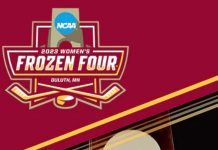Note: This is a special, part two, Thursday edition of Wednesday Women. Check out yesterday’s part one that recapped the regular season and conference tournaments before diving in on our thoughts about the NCAA tournament field selection and predictions for how we expect those teams to fare.
Arlan: I guess that I could have just started this column by hollering in all caps, “What did you think of the NCAA selections?” I hope that we can all agree on the automatic bids. Maybe? It’s fairly safe to add in Ohio State.
At that point, so much for unanimous decisions. I think that the committee’s biggest mistake was bypassing Penn State. In order to do that, they had to make the assumption that the third-best team in both Hockey East and the WCHA was better than the top team in the CHA. There have definitely been years where that was true, and there were mathematical rankings to back it up. I don’t know of any such ranking this year.
Grant Salzano put together an analysis for BC Interruption where he compared the strength of the leagues going back five years. First, I’m not sure what is magical about five years. Five years ago, none of the current players were playing college hockey, so it’s safe to assume that there could be some massive shifts in power. At the point where he was having to introduce corrections for defunct programs, programs that have been added, programs sitting out due to the virus, he should have started to introduce some sort of a plus-minus value to indicate his uncertainty. Inevitably, we need to gauge how strong programs are today, with their current rosters. Thanks to Covid, that is even more of a revolving door than usual.
About the only measure we have to use is Team Winning Percentage, where Penn State is second to only Northeastern. In terms of winning percentage, Providence was the last team into the field, with a percentage of .625. That does not compare well with the Nittany Lions at .810. Maybe the Hockey East schedule was much more rigorous, but we don’t have any accurate way to measure that. At least not to the precision where we can ignore that large of a gap in success on the ice.
Many people expected Minnesota to make the field. All of its losses were to teams seeded in the top three. That’s fine, but there were eight of those losses in 11 games. It’s one thing to play a tough schedule, but you still have to show positive results. Minnesota’s final five home games were against Wisconsin and Ohio State. The Gophers didn’t win any of those, going 0-4-1, including losing two games where they had multi-goal leads. I realize that Minnesota had a lot of injuries, particularly in the OSU series, when it had four players out. Sometimes, you just have to figure out how to use your available assets and take care of business in order to advance. Is Minnesota better than some teams selected? I think so, but that’s just an opinion and counts for less than nothing. Did Minnesota prove it belonged? I’d say that the Gophers didn’t achieve that, at least not to the extent that they proved they would be in big trouble any time they ran into Wisconsin or Ohio State.
I see the Friars resume as being very similar to that of Minnesota: a game better in terms of a record, but a less challenging schedule. The Gophers had 13 games against the top five seeds, going 4-8-1. Providence played seven games against the top six seeds, going 2-5-0. Thus, the Gophers would have a winning percentage just under 35 percent against the tournament field, while the Friars are just under 29 percent in their games versus tourney teams. I’m not suggesting that Minnesota belongs in the field over Providence, but that if the Gophers are out, it’s hard to find a measure where PC is more deserving. And if winning percentage trumped strength of schedule for UMD over Minnesota, then how can Penn State be left out? I’m not seeing it.
Penn State proved more on the ice. The Nittany Lions are 4-0 against teams in the tournament field. I don’t ever remember a team in the eight-team era being bypassed with a mark at all similar to that. In my opinion, the committee exercised a disproportionate bias against the CHA this year with respect to what can be proven. If PSU was being penalized for failing to reach its tournament final, then it doesn’t look that BC was held similarly accountable.
We are now reminded why mathematical formulas are used in most years. The committee was left to make judgements, and based on the composition of the committee, the optics aren’t encouraging that fairness was paramount.
I did appreciate that the committee didn’t give us any conference retreads in the first round, so even I will concede that they did well in that respect. That’s the end of my rant, and I’ll turn the soap box over to you, if you’re so inclined.
Nicole: It’s funny you should end with that because I’m pretty sure that exact reason is what tipped the scale against Minnesota. That’s clearly not fair nor is it a directive in the selection criteria, but since I can’t figure out a whole lot of other rhyme or reason to what they did, I think that at the end it came down to them choosing Providence to avoid Wisconsin vs. Minnesota again. Of course, that doesn’t explain why it was Providence over Penn State.
I honestly think you could drive yourself mad or at the very least create a very convincing murder mystery cork board with red string trying to unravel or make sense of the decisions that were made. They’re contradictory and don’t follow the criteria, except when they do sometimes.
Where I’ve landed on this is that I’m not super upset about the field or teams chosen generally, but I have serious concerns about the thought process used to get there – specifically the haphazard choice of which criteria they’d use and when. I wrote about this here on Monday, so I’ll try not to retread too much of that.
Clearly the committee decided UMD had been underrated and should sit higher in the rankings. What doesn’t make sense is how that doesn’t also inflate Minnesota’s case, as the Gophers beat them twice. It appears the committee weighed the Bulldogs’ record and near-win of the WCHA regular season title highly. But did not do the same for Penn State. They seem not to have taken into account Minnesota’s record against tournament teams compared to Providence’s record against tournament teams.
I said this as a bit of a fleeting thought on Twitter on Sunday night from a gas station somewhere in Northwest Wisconsin before getting back on the road home, but the more I think on it, the more I feel like Minnesota was being not just compared to UMD, but also to their own history of being a very good program.
There was a lot made of how “awful” the Gophers were because they went 3-6-1 in their final ten games. But objectively, they played eight of those games against teams ranked ahead of them in the polls. At the time, the number one and three teams in the nation. Three of the final four games against UW and OSU were one-goal losses and in the fourth, they tied Wisconsin and won the shootout. The Gophers then finished the regular season with the kind of wins over Bemidji that people are mad UMD didn’t have.
I’m sorry, but no one ranked below the Gophers in the polls would have done any better over that stretch. People think Minnesota is somehow awful because of that ten game record because of their own expectations for what the Gophers “should” do. It’s unfair and it says so much about the standard they’re held to that being ranked fifth in the country is considered a “awful” year for them.
Now I’ll negate all the goodwill I may have gathered from Gopher fans by agreeing with what you said above about needing to work with what you have and pointing out that Minnesota had the ability to prove their case via the WCHA tournament. In 2018, they were in a win-or-go-home situation where they were unlikely to get an NCAA bid unless they won the auto bid. So they went out and won the auto bid. There’s no controversy here if they’d made a better case.
It may be a little contradictory or convoluted, but I both think Minnesota has some blame to shoulder for not doing much over the final month to convince the committee they were worthy of a bid and that, consciously or not, the committee judged them differently than they may have another team based on past success.
As a friend said, this whole debacle made me miss Pairwise. Pairwise! The formula that’s actually not a very good tool for women’s hockey. And still, I now know I can’t complain about it again because clearly things get much, much worse. Unreal.
Arlan: As for what stands out to me in the quarterfinals, I would say that the Boston College versus Ohio State game looks like a trap game for the Buckeyes. With a potential rematch with Wisconsin looming in the next round just a couple of days later, they could look past BC. OSU is good, very good, but it’s not good enough to defeat an opponent of that caliber with less than its usual intensity.
The other problem for the Buckeyes is there are questions about the health and availability of first-line center Liz Schepers, and she’s a big piece of their puzzle. Three years have passed since these teams met and the Eagles were eliminated on home ice in this same round, so I don’t know how much motivation they will take from that memory. They’re still a dangerous team, and if they put it all together, there is definitely enough talent to turn the tables. This is still a relatively new role for Ohio State, going from the up-and-coming team with something to prove to the favored team that is expected to win.
In the other openers, I expect that RMU will be better prepared for this stage in its second national tournament, but Northeastern is too good.
Colgate is underappreciated and has a ton of young talent. The Bulldogs on Saturday didn’t look like they were on the cusp of greater things, but maybe they can recharge during the extra days between games. The No. 4 seed is often the most vulnerable, but I don’t get that feeling this time.
Finally, Wisconsin is a lock. Defensively, the Badgers aren’t as strong as they typically are, but I don’t think that the Friars have the necessary firepower to exploit that. I’m sure that they’ll put forth their best effort, and kudos to them for overcoming Covid and making it this far.
Here is where it always gets difficult, analyzing potential matchups that might never happen. A person could lose a lot of money over the years trying to pick NCAA Champions from Hockey East, but I have a different sense about the Huskies. The field is a bit weaker with only one ECAC entry, the WCHA doesn’t have one team that is so scary good that nobody can hang with them, so it doesn’t look like an impossible task. No disrespect to Colgate, but I think that the Raiders are probably a year away, so I’m going to be the slow learner and pick the Hockey East champ — Northeastern.
Are you looking closer to home?
Nicole: I both agree with your assessment that the BC/OSU matchup is the one most likely to yield an upset and think that Ohio State has a good chance at winning it all. How’s that for useless predictions?
First of all, they’re probably the most well-rested of all the teams in the field, having had three weeks off before the conference tournament. There are lingering questions about what happens if they don’t have Schepers, but the rest of the team had a chance to rest the aches and pains that come from a season, which is a rare luxury this time of year.
The thing about the Buckeyes that won’t let me overlook them is their tenacity. When they get going, they’re steamrolling and despite the fact that they should probably be scoring more with the offensive firepower and number of shots they take, they consistently come back in games where they’re down and force teams to beat them. When they get moving, they gain momentum and confidence exponentially and it makes them very hard to beat.
I think Northeastern is probably the team to beat right now, but I also would feel much better about wholeheartedly picking them if they’d played a top tier team. I know they are good, but I’m not sure I have a real grasp on exactly how good. My indecision on how the Frozen Four, particularly, will play out has more to do with what I know Colgate, Wisconsin and Ohio State are capable of. What I don’t feel like I know as well is how the Huskies will respond.
They looked messier than I’d have thought at this point of the year against UConn in the Hockey East semifinal. UConn is better than they get credit for, but they had goalie Aerin Frankel moving quite a bit around the net and I think had NU back on their heels a bit. It felt like a little bit of a crack in their otherwise pretty darn solid armor.
Both Wisconsin and Ohio State matchup up well against their speed and that explosive top line. Having watched both teams handle a lot of forechecking pressure and keep the area around their net fairly clear this weekend, it makes me think either one could do a bit to slow down Alina Mueller and Chloe Aurard. The key would be halting or interrupting the breakout before or as it’s happening. If Northeastern is able to easily move through the zones, I think they have the advantage. But I think messing with their rhythm and accelerating the need to make decisions might be the key to shutting them down.
Of course, that’s all assuming the Huskies get past Colgate, which is also not a given.
The case for Wisconsin, for me, begins and ends at their depth. They are dangerous in so many different ways through four lines. The past three games, Lacey Eden and Daryl Watts have been paired on their second line and are explosive together. They’re dynamic in different ways and it’s a lot for teams to handle. Eden herself said she scored the championship game-winner in overtime because the defender and the goalie were cheating towards Watts – a valid choice on their part, but Eden is proving to be just as lethal and it forces defenders to make an impossible choice. In the semifinal, the scoring came from the rookies on the third line after Minnesota did a good job sticking to Watts, Eden, Britta Curl and Brette Pettet.
As they lined up this weekend, the Huskies’ top top lines have 115 total points. Wisconsin’s top two lines have 108 total points. The difference is Northeastern’s is split with 75 on the top line and 40 on the second. Wisconsin’s points are evenly distributed across the two lines – 54 points each.
We’ve talked all year about how defense is one of the Badgers’ weakest spots. An interesting thing to evolve out of that is I feel like we’re seeing better, stronger back-checking from the forwards. I’d also give Eden credit for some of that. She is aggressive on both ends of the ice and was throwing her body in front of pucks on the defensive end from her very first game in a Wisconsin sweater. That has set a precedent and I think the rest of the team has stepped up to that challenge.
Similarly, I think the team as a whole has adapted and improved their game this year in response to the fact that Kennedy Blair plays a different style than Kristen Campbell did. Blair tends to deflect and push aside pucks more than freeze them. Her teammates have gotten much better at staying close, looking for pucks and clearing them. Both things have changed Wisconsin’s defense in ways I didn’t expect to start the season.
Even still, the Badgers will get scored on. Their M.O. this year is definitely more “put away more pucks than the other team” than “shut down the opponent.” With their defense and Frankel in ne on the other end, that would be no easy task.
It would be great to see numbers one and two face off in the title, but there’s absolutely no guarantee that either of them will make it that far and if either of them gets ahead of themselves, their run will be over before it begins.


